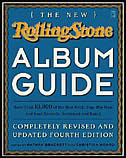| Working Drafts and Notes For: [The New] Rolling Stone Album Guide |
 |
James Carter
| JC on the Set (DIW, 1994) | |
| Jurassic Classics (DIW, 1995) | |
| The Real Quietstorm (Atlantic, 1995) | |
| Conversin' With the Elders (Atlantic, 1996) | |
| In Carterian Fashion (Atlantic, 1998) | |
| Layin' in the Cut (Atlantic, 2000) | |
| Chasin' the Gypsy (Atlantic, 2000) | |
| Gardenias for Lady Day (Columbia, 2003) | |
| Live at Baker's Keyboard Lounge (Warner Bros., 2004) |
Taken as a group, it's now clear that the one and only purpose of James Carter's first three albums is to impress the hell out of the listener. He plays saxophone in four weight divisions, plus bass clarinet and bass flute. He's mastered just about every sound those horns can produce, from honks through squeals, and particularly enjoys those pops and clicks on the valves that make for self-accompanied percussion. He shows off his circular breathing. About the only trick in the book he hasn't worked in (yet) is Rahsaan Roland Kirk's siren.
Carter also shows of his mastery of the history and lore of the saxophone, not only using Ellington and Monk standards as lauchpads, but digging up Sun Ra, and resurrecting Don Byas and little-known Texas tenor John Hardee. The DIW albums careen between tradition and avant-garde, but Carter's real breakthrough comes in The Real Quietstorm, where he concentrates on ballads and lets the luscious melodies outshine the performance.
Having established himself as the most imposing young saxophonist since Sonny Rollins, Carter next moved to consolidate his reputation by Conversin' With the Elders. Of course, when you're as young as Carter, elders can be as modern as Hamiett Bluiett and Lester Bowie, or as ancient as Buddy Tate and Sweets Edison, and the juxtaposition, which lets Carter reprise "Moten Swing" from the Altman movie, play reggae with Bowie, and do dueling baritones with Bluiett, is one of Carter's most broadly enjoyable albums.
Carter's major label efforts are all concept albums. In Carterian Style is meant to be a tenor-organ showcase, but it defies all expectations: Carter has no desire to settle into a soul jazz groove, so his pairing with three organists starts as jousts and quickly turns into a rout: his most out recording, but not an especially successful concept.
The next two albums represent Carter's first work with guitarists. Layin' in the Cut features two electric guitarists and funk bassist Jamaaladeen Tacuma working out of a groove perhaps a bit too reminiscent of Ornette Coleman's Prime Time. Meanwhile, Chasin' the Gypsy uses two acoustic guitarists to reconsider Django Reinhardt's swing, with cousin Regina Carter playing Grappelli on violin, resounding evidence that everything old can be new again. Plus, it lets Carter show off his new bass saxophone.
After an unseemly hiatus, Carter switched to Columbia and Warners flushed out a live album that Atlantic had sat on since 2001. Gardenias for Lady Day was overstrategized: ostensibly a Billie Holiday tribute, half of the songs had nothing to do with her, the two vocals were hammed up by an Ella wannabe, "Strange Fruit" reconceived as a noise break, much of the rest buried in maudlin strings. On the other hand, the rhythm section was perfectly tuned for Carter's postmodern '40s jones, and Carter was incandescent. Live is another oddball, with a panoply of guest saxophonists who can hardly get a note in edgewise -- Franz Jackson even resorts to a blues shout. Carter is bursting with talent and ideas; it's a shame that he doesn't get more opportunities to work out.
Notes
| Saxemble: | |
| Saxemble (1996, Qwest/Warner Bros.) | |